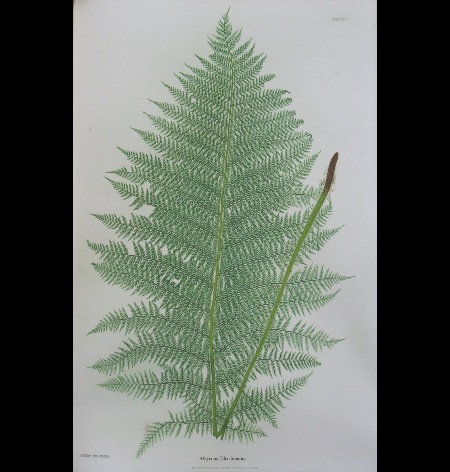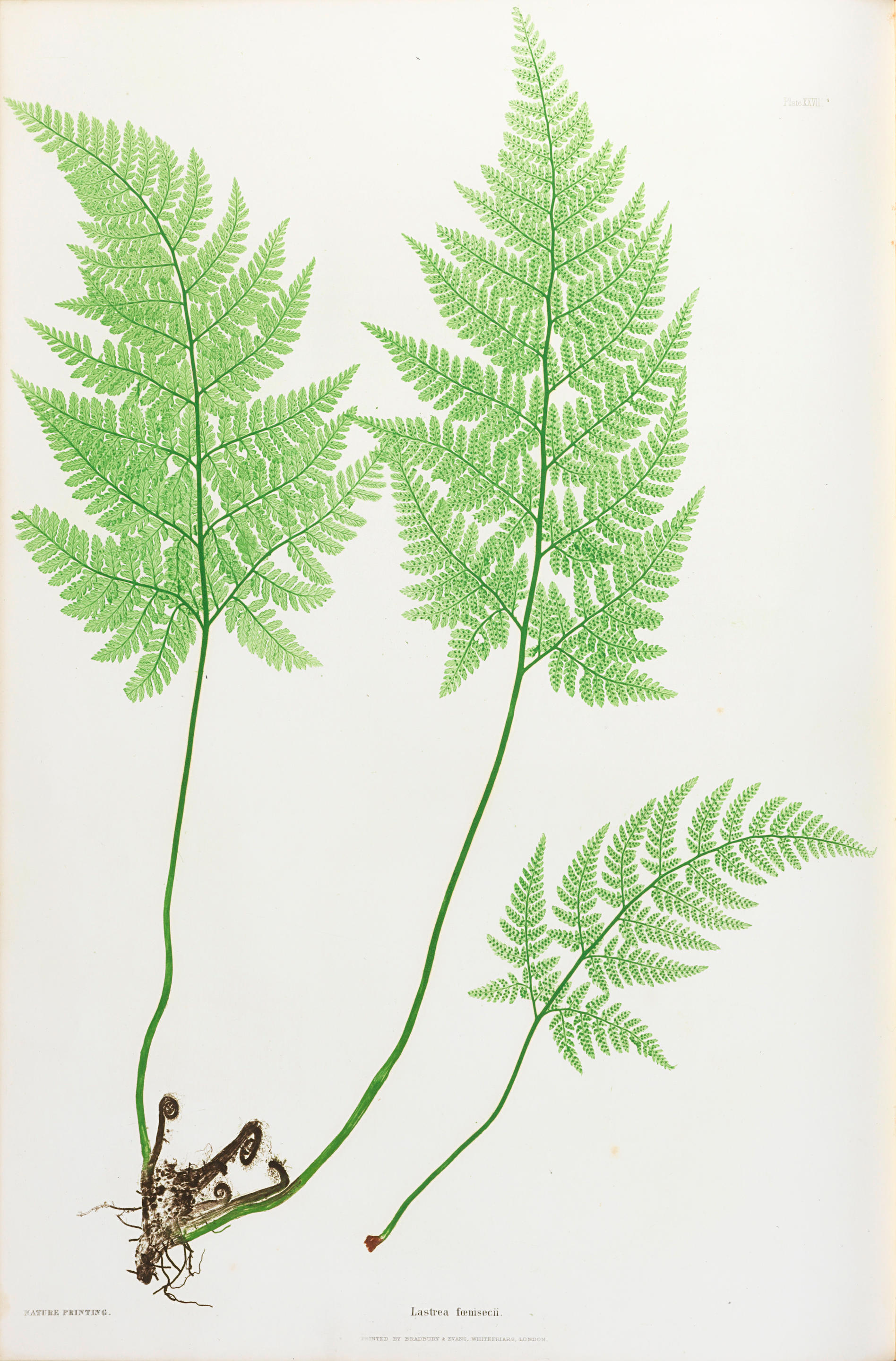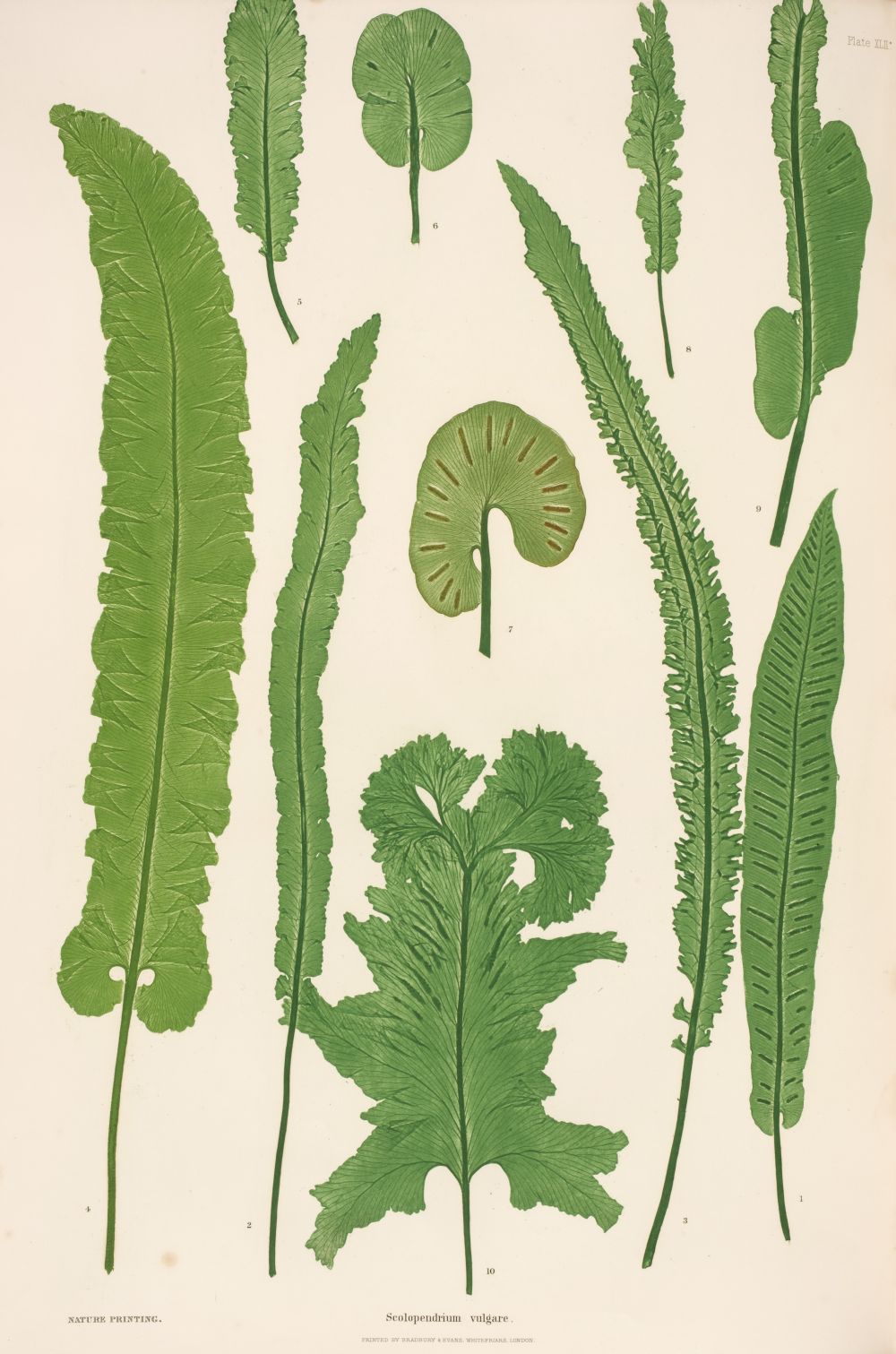MOORE, Thomas (1821-1887). The Ferns of Great Britain and Ireland... Edited by John Lindley... Nature-printed by Henry Bradbury London: Bradbury & Evans, 1855[-1856]. 2° (542 x 365mm). Half-title. 51 nature-printed plates, all printed in colours by Bradbury & Evans under the direction of Henry Bradbury (Some spotting, 9 plates shaved with slight loss to image area or imprint.) Contemporary green morocco gilt, endpaper watermarked date 1865, covers with wide decorative border in gilt and blind gilt fillets and repeated naturalistic fern frond tool, the upper cover with the title tooled in gilt in the central panel, spine in seven compartments with raised bands, the bands highlighted in gilt, each compartment with repeat decoration of a single centrally-placed fern frond tool in gilt, gilt turn-ins, marbled endpapers, g.e. (extremities bumped and worn). FIRST EDITION OF BRADBURY'S CHEF D'OEUVRE AND AN IMPORTANT EXAMPLE OF NATURE PRINTING. Henry Bradbury (1831-1860), eldest son of William Bradbury of Bradbury & Evans, published the present work in 17 monthly parts between June 1855 and September 1856. With text by Thomas Moore (curator of the Chelsea botanic garden and co-editor of Gardener's Chronicle ) and edited by John Lindley (1799-1865), the work was one of the first of the genre printed in Britain. Bradbury went on to publish a four-volume work with nature-printed plates of seaweeds (W.H. Johnstone & A. Croall. The nature-printed British Seaweeds . London: 1859-60). Bradbury had learnt of nature-printing through studying at the Imperial Printing Office in Vienna. Alois Auer the director of the Office, had patented the process with his associate Andreas Worring in October 1852. Bradbury returned to London where he patented an improved version of the process without (or so Auer alleged) sufficiently acknowledging his indebtedness to Auer and Worring. Auer reacted badly and in print called Bradbury a liar and a dishonest drunk. It is not known how the controversy affected Bradbury, but he committed suicide at the age of 29 by drinking acid. He left a number of unfinished projects, including two further nature-printed works on fungi and trees. BM(NH) III,p.1345; Fischer 89; Nissen BBI 1400; Stafleu & Cowan 6275.
MOORE, Thomas (1821-1887). The Ferns of Great Britain and Ireland... Edited by John Lindley... Nature-printed by Henry Bradbury London: Bradbury & Evans, 1855[-1856]. 2° (542 x 365mm). Half-title. 51 nature-printed plates, all printed in colours by Bradbury & Evans under the direction of Henry Bradbury (Some spotting, 9 plates shaved with slight loss to image area or imprint.) Contemporary green morocco gilt, endpaper watermarked date 1865, covers with wide decorative border in gilt and blind gilt fillets and repeated naturalistic fern frond tool, the upper cover with the title tooled in gilt in the central panel, spine in seven compartments with raised bands, the bands highlighted in gilt, each compartment with repeat decoration of a single centrally-placed fern frond tool in gilt, gilt turn-ins, marbled endpapers, g.e. (extremities bumped and worn). FIRST EDITION OF BRADBURY'S CHEF D'OEUVRE AND AN IMPORTANT EXAMPLE OF NATURE PRINTING. Henry Bradbury (1831-1860), eldest son of William Bradbury of Bradbury & Evans, published the present work in 17 monthly parts between June 1855 and September 1856. With text by Thomas Moore (curator of the Chelsea botanic garden and co-editor of Gardener's Chronicle ) and edited by John Lindley (1799-1865), the work was one of the first of the genre printed in Britain. Bradbury went on to publish a four-volume work with nature-printed plates of seaweeds (W.H. Johnstone & A. Croall. The nature-printed British Seaweeds . London: 1859-60). Bradbury had learnt of nature-printing through studying at the Imperial Printing Office in Vienna. Alois Auer the director of the Office, had patented the process with his associate Andreas Worring in October 1852. Bradbury returned to London where he patented an improved version of the process without (or so Auer alleged) sufficiently acknowledging his indebtedness to Auer and Worring. Auer reacted badly and in print called Bradbury a liar and a dishonest drunk. It is not known how the controversy affected Bradbury, but he committed suicide at the age of 29 by drinking acid. He left a number of unfinished projects, including two further nature-printed works on fungi and trees. BM(NH) III,p.1345; Fischer 89; Nissen BBI 1400; Stafleu & Cowan 6275.










.jpg)



Try LotSearch and its premium features for 7 days - without any costs!
Be notified automatically about new items in upcoming auctions.
Create an alert